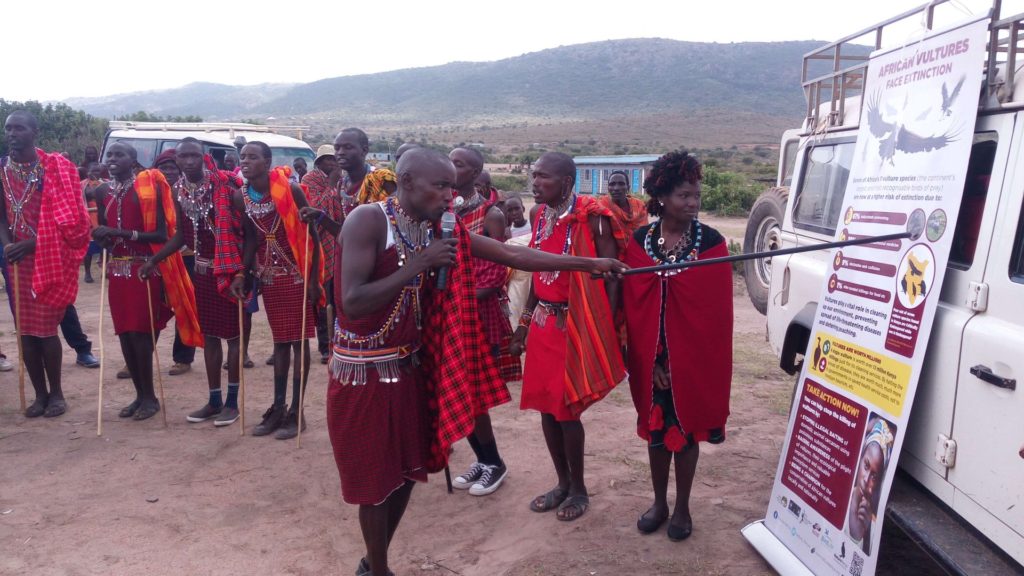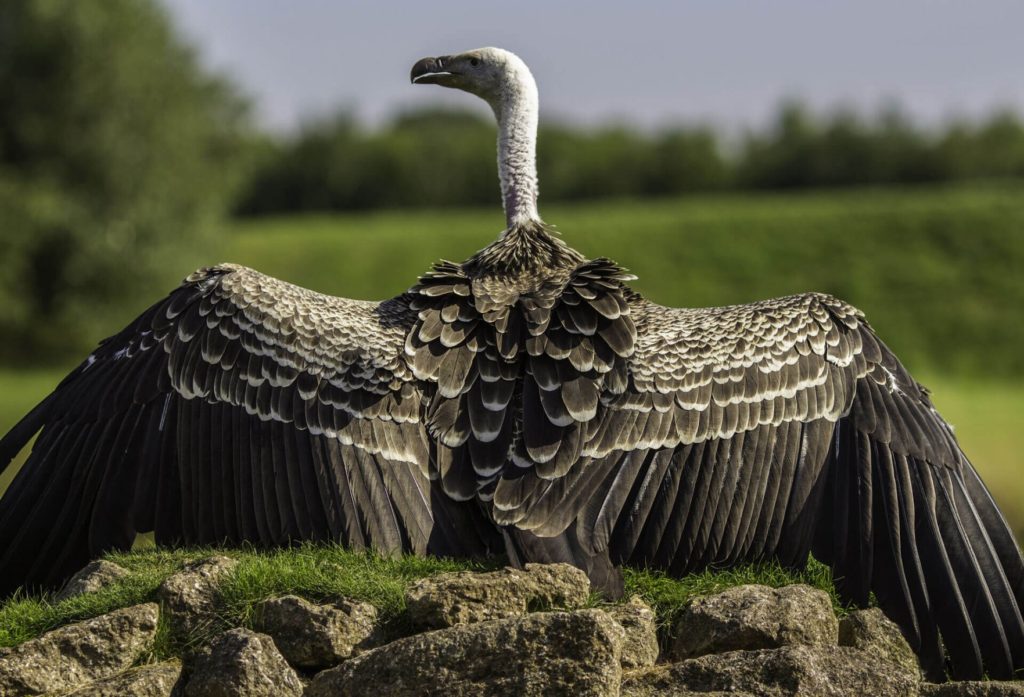By Jessica Law
A vulture rides the thermals a thousand meters above the ground, the savanna laid out before her in a vast, emerald patchwork. Her soaring may look serene, but her eyes are constantly trained on the vista below, scanning the plains and thickets for one thing: food.
A vulture’s eyesight is needle-sharp; they can locate a recently-deceased animal carcass from as much as a mile away. And when we say recent, we mean recent. Vultures typically arrive on the scene within an hour of death, having traveled as many as 200 kilometers [about 124 miles] that day in search of a meal. Then they get to work, picking the bones clean before disease has time to spread, far faster than scavengers such as feral dogs or rats can achieve. If you think about it, they are performing a huge service. But for how long?
Nowadays, what looks like an inviting meal could turn out to be deadly poison. Human encroachment upon wild spaces has led to an increase in human-wildilfe conflict, and people have started lacing animal carcasses with toxic agricultural pesticides such as carbofuran. In many cases, vultures are not the intended victims. Farmers may put out poisoned bait in order to kill off predators such as lions that would otherwise take their livestock, unaware of the accidental avian casualties.
Another more pernicious practice comes from ivory poachers not wanting to draw attention to their illegal activities. Vultures, in their capacity as the “sentinels of the sky,” can detect a dead elephant far faster than any park ranger would, and flocks of circling birds could alert law enforcement before the poachers had time to flee the scene. To prevent this, poachers often douse the carcass in poison.
The results can be utterly devastating. If nothing is done, a laced elephant carcass can kill 500 vultures, and even a poisoned cattle carcass can claim 150 lives. Cumulatively, this has dealt an enormous blow to vulture populations across Africa. Poisoning is by far the biggest threat to Africa’s vultures, causing 60% of deaths. Now, seven of Africa’s 11 species find themselves threatened with extinction, and their decline has been alarmingly rapid: a plummet of 80-97% over just three generations. Four species are now listed as Critically Endangered, teetering on the very brink of disappearance.
The effect of their absence is already being felt. A recent study in Laikipia County, Kenya demonstrated that in the absence of vultures, animal carcasses are taking longer to be consumed or decompose, increasing the risk of disease transmission. Conservationists in Africa were eager to avoid a repetition of the huge humanitarian and financial cost incurred by the Asian vulture crisis. in 2016, Nature Kenya, a BirdLife Partner, received much-valued support to launch a visionary program: “Preventing Poisoning to Save Africa’s Vultures,” which, if successful in Kenya, could be rolled out across the whole continent.
“Attitudes have changed very positively”
A priority of this program was to introduce a rapid response protocol, whereby a poisoned carcass could be spotted and disposed of before it could cause any more deaths. In spring of this year, 89 rangers across the Maasai Mara, a protected area in Southwestern Kenya, were trained and equipped in readiness. Training included how to identify and dispose of the source of poisoning, getting veterinary help for sick animals, and even gathering evidence so that the perpetrators might be found and prosecuted. These rangers then went on to train 117 more of their colleagues, spreading their knowledge to create a network across the Maasai Mara Ecosystem.
However, rangers can’t be everywhere at once. Another important link in the chain is to educate the community about the importance of vultures in their everyday lives. Because as much as we love vultures, it’s understandable why people may have negative associations with them: famine, pestilence, death, the enormous shadow looming overhead wherever anyone is butchering meat. It’s not always obvious that these are actually shy, harmless creatures.
To clear the vulture’s name, Nature Kenya embarked on a large-scale publicity campaign. In villages across the Mara, rangers attended regular bazaars (village meetings) to talk to local people. Drama groups such as the Buffalo Dancers performed at markets to raise awareness, and the documentary Vanishing Vultures was aired on national television. At every opportunity, residents were told who to contact and what to do if they witnessed a poisoning.

The Buffalo Dancers use comedy and theater to change views. Image credit Rebecca Ikachoi, Nature Kenya.
“Attitudes have changed very positively,” says Samuel Bakari, Vulture Conservation Officer for BirdLife International. “Community members are more alert. While a dead vulture would have not attracted any attention before, now people are on the lookout, and this means that any poisoning case that would otherwise have gone unnoticed is very likely to be noticed quickly.”
On February 9th 2018, this was put into practice when rangers barely out of training were called out to their first rapid response. A researcher with the Mara Martial Eagle Project had spotted a poisoned vulture on Paradise Plains, and the bird was rushed into veterinary care. Rangers patrolled the area, uncovering further vulture casualties, but on this occasion were unable to find the source of poisoning.
“The case elicited a very high level of response from various individuals and institutions, but being the first, it also provided good learning opportunity on how we can improve and what the likely challenges are,” concludes Bakari. One improvement was the creation of a dedicated WhatsApp group–a simple but effective way to communicate even more quickly.
Fast forward to August 2nd, and a huge triumph showed just how effective the rapid response unit can be. A local community member came across a poisoned hyena at the border of Olare Motorogi Conservancy, and reported it instantly. The carcass was disposed of so quickly that there were no vulture casualties whatsoever. Hundreds of potential deaths were prevented.
The work is still ongoing. In the courtrooms, steps are being taken to ensure anti-poisoning laws are enforced at a local level. Vultures are being satellite-tagged to understand their movements further. But with enough support, we hope that the sentinels of the sky will soon be able feast in safety once again. After all they’ve done for us, it’s the least we can do.
Preventing Poisoning to Save Africa’s Vultures is financed by BAND Foundation and jointly implemented by Nature Kenya, The Peregrine Fund and BirdLife International. This work in Kenya is also supported as part of a program to tackle vulture poisoning running jointly across Kenya, Botswana and Zimbabwe, funded by Fondation Segré. The program feeds into the ambitious Multi-species Action Plan to save all threatened vulture species over 128 countries in Africa and Eurasia.






